
![(1) The drone flying over the structure gives an incident commander (IC) a bird’s-eye view of the structure and all interior walls, which allows him to assess the building area’s stability that is not visible from the street. <i>(Photos by Trevor Hogan.) </i>“></td></tr><tr><td>(1) The drone flying over the structure gives an incident commander (IC) a bird’s-eye view of the structure and all interior walls, which allows him to assess the building area’s stability that is not visible from the street. <i>(Photos by Trevor Hogan.)</i></td></tr></tbody></table></figure>
<p>Recently (and often), drones [also known as unmanned aerospace vehicles (UAVs)] and the fire service have been in the news together. For instance, the presence of drones in wildfire fighting aircraft airspace has grounded all aircraft fighting the fire until the drone has vacated the area, and one video has surfaced showing a nozzle firefighter trying to knock down a drone with a hose stream.</p>
<p>Like it or not, drones are here to stay, and the fire service must be out in front on the issue, or we will be left behind. Much of this deals with educating the public and working with local, state, and the federal government to understand the current laws and then getting those laws in place to deal with the issues that drones pose.</p>
<table width=](https://emberly.fireengineering.com/wp-content/uploads/2016/05/1605FE_FFpic1.jpg)
|
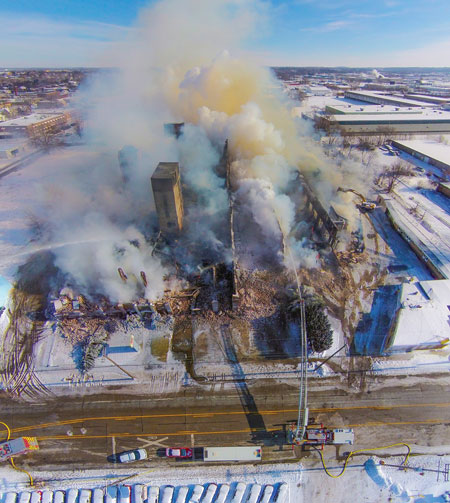 |
| (2) This aerial view is being used to search areas for victims or indications of victims. |
A local fire department will need permission from the Federal Aviation Administration (FAA) to fly a drone. The FAA is not granting licenses to fire departments and most other government agencies at this time. However, a local hobbyist is allowed to fly a drone with limited restrictions. These rules are now in place, and they will continue to impact the fire service’s use of drones.
Fire Scene Use
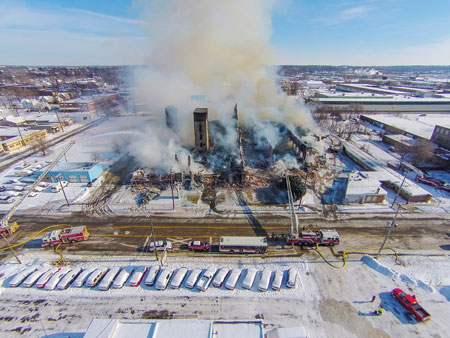 |
| (3) The IC uses this view to ascertain if the elevated streams are reaching the areas that need them. |
A drone can assist a fire department in many ways, such as searching for missing persons, water rescues, highway incidents (where they can arrive before the first due), wildland fires, searches in remote locations, and operations in extreme weather conditions. They can also go places where firefighters may be reluctant to go, such as heavily involved areas.
On January 6, 2015, in Rockford, Illinois, a multiple-alarm fire occurred in a vacant four-story heavy timber warehouse. The fire was believed to have started in an area of the building being used for an illegal marijuana growing operation. The building’s sprinkler system was offline because the structure was vacant and heating was being used to prevent the pipes from freezing. These factors, combined with the heavy timber construction, caused the fire to spread rapidly to the entire structure. The large volume of fire, damage to the building’s structure, and the unknown condition of the interior dictated an exterior defensive attack.
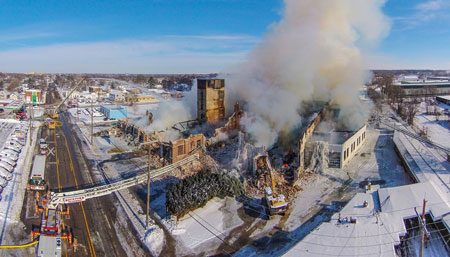 |
| (4) In this view, the grappler is demolishing parts of the structure to gain safe access to the seat of the fire. The IC can watch this operation live and make sure his personnel and equipment are safe. |
Trevor Hogan, the photographer for this article, is a Rockford (IL) Fire Department (RFD) firefighter. He was called to the scene to deploy his personal drone to document the incident and the fire, which is believed to be the second largest in Rockford’s history. An additional benefit of his drone was its ability to help the RFD supply local media outlets with footage of the fire, which was controlled and released with approval from the incident commander and the public information officer.
The next day, the drone operator was asked to return to the scene to aid the fire investigation unit, which needed a closer look at the fire scene and to locate the possible area of origin. The weather was bitterly cold, with a 0°F temperature and a -30°F windchill, but the drone moved from area to area without impacting the structure or having to worry about falling on the ice.
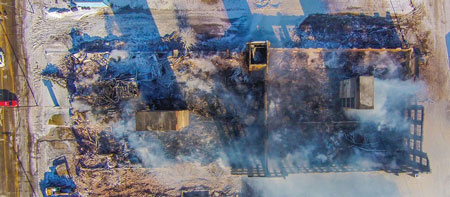 |
| (5) This aerial map of the building allows the IC to see hot spots. Also, other cooperating agencies can also see where they can begin investigating. |
With the evolving story of a possible involvement of an illegal drug operation in the fire’s cause as well as the unknown fate of missing persons thought to be in charge of the operation, the drone’s search was critical to investigators, who needed the drone to take photos and videos directly above the fire location, looking for signs and indicators (i.e., vehicles) of the victims’ presence. The drone also allowed a live, real-time aerial shot of the scene, which enabled investigators to coordinate and section off areas of the structure to facilitate investigations of multiple jurisdictions and assisted in making the scene safer. From this, agencies such as the local fire and police departments, the state fire marshal, and the state police can work in areas where they need to investigate and not unnecessarily duplicate services. The drone also helped the fire suppression unit determine hot spots; thus, the aerial ladder tips did not have to be staffed in such frigid conditions.
 |
| (6) A view of the rear side of the structure, which cannot be seen from the command post or by the IC. |
Use in Testing and Buy-In
The RFD also uses drone footage to educate firefighter candidates about the department’s physical ability testing process. All candidates and applicants are shown drone footage of course layouts and sequences to ensure that the test is as transparent to them as possible. This ensures that the candidates are informed of the process, and it limits the department’s exposure to a lawsuit in the event of a failed test.
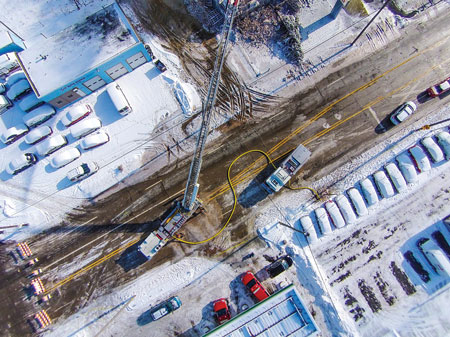 |
| (7) This view allows the fire department to release a photo to the media without compromising any of the scene photos. |
Other drone footage documented the need for a new fire station on Rockford’s west side, an area that had not seen a new fire station in 75 years. The quality and presentation of the footage helped create buy-in from local politicians; community groups and members; and, most importantly, the taxpayers. These people supported the new fire station in no small part because of this exciting drone’s-eye view of the town; viewers saw the possibility of a new fire station as a huge positive for the community rather than perceiving it as the drain that it could have been. Now, that’s progress!
Recently, two large tornadoes struck northern Illinois. Technical rescue teams were deployed immediately after the tornadoes swept through the area. The scene was one of complete destruction, and the subsequent searches of affected structures lasted for several days. Although no drones were deployed, they would have been a huge help in the early hours of the rescue efforts. They might also have been used to survey damage, to map search areas for responding teams, and to find the best access points for emergency teams and vehicles that needed to get to the wreckage. Drones can also eliminate the possibility of duplicating rescue efforts, which occurs at many large-scale incidents through coordination of search areas.
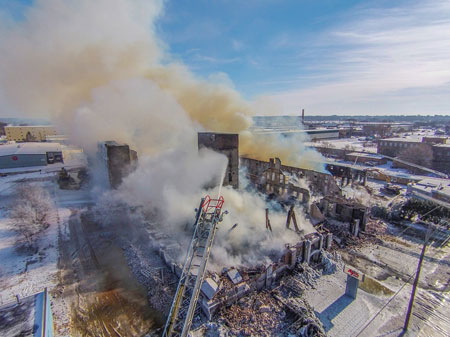 |
| (8) This view allows the IC to see if the aerial device’s stream is effective and if it can be repositioned safely. |
The FAA has blanket restrictions on “commercial” drone use, and the fire service falls into the commercial use sector. The FAA is lagging behind in making formal laws and regulations for drone pilots to follow; this leaves a lot of gray area as well as many questions for government agencies like the fire service regarding flying drones for specific uses. As of now, the FAA allows only hobbyists to fly drones. So, when fire departments want to use a drone, are they using it as a hobby or commercially? That is certainly up for debate.
Drones have many practical purposes in the fire service. When you can deploy them safely, they can recon large areas faster, and they get “eyes” on the fire scene in unique ways that help commanding officers make quicker and safer decisions. It is time for the fire service to get out in front on this issue and make our voices heard.
 |
| (9) Here, the south wall is standing unsupported, and the IC can size it up. Is it leaning and, if so, where? This view is helpful in determining the tactics needed in that area. |
MICHAEL M. DUGAN is a 40-year fire service veteran and a 29-year member of the Fire Department of New York (FDNY), where he served as captain of Ladder Company 123 in Crown Heights, Brooklyn. As a lieutenant, he served in Ladder Company 42 in the South Bronx. While assigned as a firefighter in Ladder Company 43 in Spanish Harlem, he received the James Gordon Bennett Medal in 1992 and the Harry M. Archer Medal in 1993, FDNY’s highest award for bravery. He was a volunteer firefighter in Halesite, New York. He lectures on truck company operations, building construction, size-up, and today’s fire service.
More Fire Engineering Issue Articles
Fire Engineering Archives

